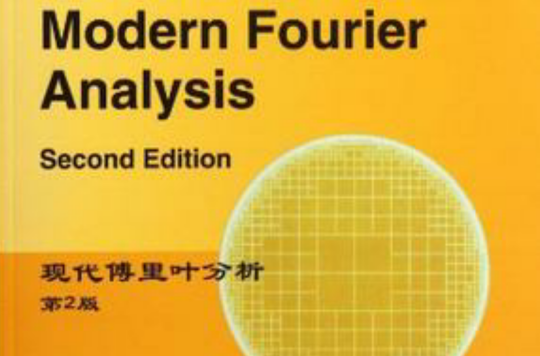《現代傅立葉分析》是2011年世界圖書出版公司出版的圖書,作者是格拉法克斯。本書旨在為讀者提供學習歐幾里得調和解析領域的理論基礎。
基本介紹
- 作者:格拉法克斯
- ISBN:9787510040603
- 頁數:504
- 定價:59.00元
- 出版時間:2011-1
- 副標題:現代傅立葉分析
內容介紹
作品目錄
6.1 riesz and bessel potentials, fractional integrals
6.1.1 riesz potentials
6.1.2 bessel potentials
exercises
6.2 sobolev spaces
6.2.1 definition and basic properties of general sobolev spaces
6.2.2 littlewood-paley characterization of inhomogeneous
sobolev spaces
6.2.3 littlewood-paley characterization of homogeneous
sobolev spaces
exercises
6.3 lipschitz spaces
6.3.1 introduction to lipschitz spaces
6.3.2 littlewood-paley characterization of homogeneous
lipschitz spaces
6.3.3 littlewood-paley characterization of inhomogeneous
lipschitz spaces
exercises
6.4 hardy spaces
.6.4.1 definition of hardy spaces
6.4.2 quasinorm equivalence of several maximal functions
6.4.3 consequences of the characterizations of hardy spaces
6.4.4 vector-valued hp and its characterizations
6.4.5 singular integrals on hardy spaces
6.4.6 the littlewood-paley characterization of hardy spaces
exercises
6.5 besov-lipschitz and triebel-lizorkin spaces
6.5.1 introduction of function spaces
6.5.2 equivalence of definitions
exercises
6.6 atomic decomposition
6.6.1 the space of sequences fa,qp
6.6.2 the smooth atomic decomposition of fa,q
6.6.3 the nonsmooth atomic decomposition of fa,q
6.6.4 atomic decomposition of hardy spaces
exercises
6.7 singular integrals on function spaces
6.7.1 singular integrals on the hardy space ht
6.7.2 singular integrals on besov-lipschitz spaces
6.7.3 singular integrals on hp(rn)
6.7.4 a singular integral characterization ofh1 (rn)
exercises
7 bmo and carleson measures
7.1 functions of bounded mean oscillation
7.1.1 definition and basic properties of bmo
7.1.2 the john-nirenberg theorem
7.1.3 consequences of theorem 7.1.6
exercises
7.2 duality between h1 and bmo
exercises
7.3 nontangential maximal functions and carleson measures
7.3.1 definition and basic properties of carleson measures
7.3.2 bmo functions and carleson measures
exercises
7.4 the sharp maximal function
7.4.1 definition and basic properties of the sharp maximal function
7.4.2 a good lambda estimate for the sharp function
7.4.3 interpolation using bmo
7.4.4 estimates for singular integrals involving the sharp function
exercises
7.5 commutators of singular integrals with bmo functions
7.5.1 an orlicz-type maximal function
7.5.2 a pointwise estimate for the commutator
7.5.3 lp boundedness of the commutator
exercises z
8 singular integrals of nonconvolution type
8.1 general background and the role of bmo
8.1.1 standard kernels
8.1.2 operators associated with standard kernels
8.1.3 calder6n-zygmund operators acting on bounded functions
exercises
8.2 consequences of l2 boundedness
8.2.1 weaktype (1, i) and/_,p boundedness of singular integrals
8.2.2 boundedness of maximal singular integrals
8.2.3 h1 → l1 and l∞→bmo boundedness of singular integrals
exercises
8.3 the t(1) theorem
8.3.1 preliminaries and statement of the theorem
8.3.2 the proof of theorem 8.3.3
8.3.3 an application
exercises
8.4 paraproducts
8.4.1 introduction to paraproducts
8.4.2 l2 boundedness of paraproducts
8.4.3 fundamental properties of paraproducts
exercises
8.5 an almost orthogonality lemma and applications
8.5.1 the cotlar-knapp-stein almost orthogonality lemma
8.5.2 an application
8.5.3 almost orthogonality and the t(1) theorem
8.5.4 pseudodifferential operators
exercises
8.6 the cauchy integral of caldertn and the t(b) theorem
8.6.1 introduction of the cauchy integral operator along a lipschitz curve
8.6.2 resolution of the cauchy integral and reduction of its l2 boundedness to a quadratic estimate
8.6.3 a quadratic t(1) type theorem
8.6.4 a t(b) theorem and the l2 boundedness of the cauchy integral
exercises
8.7 square roots of elliptic operators
8.7.1 preliminaries and statement of the main result
8.7.2 estimates for elliptic operators on rn
8.7.3 reduction to a quadratic estimate
8.7.4 reduction to a carleson measure estimate
8.7.5 the t(b) argument
8.7.6 the proof of lemma 8.7.9
exercises
9 weighted inequalities
9.1 the at, condition
9.1.1 motivation for the at, condition
9.1.2 properties of at, weights
exercises
9.2 reverse htlder inequality and consequences
9.2.1 the reverse helder property of at, weights
9.2.2 consequences of the reverse holder property
exercises
9.3 the a** condition
9.3.1 the class of a∞ weights
9.3.2 characterizations of a∞ weights
exercises
9.4 weighted norm inequalities for singular integrals
9.4.1 a review of singular integrals
9.4.2 a good lambda estimate for singular integrals
9.4.3 consequences of the good lambda estimate
9.4.4 necessity of the at, condition
exercises
9.5 further properties of ap weights
9.5.1 factorization of weights
9.5.2 extrapolation from weighted estimates on a single d~0
9.5.3 weighted inequalities versus vector-valued inequalities
exercises
10 boundedness and convergence of fourier integrals
10.1 the multiplier problem for the ball
10.1.1 sprouting of triangles
10.1.2 the counterexample
exercises
10.2 bochner-riesz means and the carleson-sjolin theorem
10.2.1 the bochner-riesz kernel and simple estimates
10.2.2 the carleson-sj01in theorem
10.2.3 the kakeya maximal function
10.2.4 boundedness of a square function
10.2.5 the proof of lemma 10.2.5
exercises
10.3 kakeya maximal operators
10.3.1 maximal functions associated with a set of directions
10.3.2 the boundedness of σn on lp(r2)
10.3.3 the higher-dimensional kakeya maximal operator
exercises
10.4 fourier transform restriction and bochner-riesz means
10.4.1 necessary conditions for rp→q(sn-1) to hold
10.4.2 a restriction theorem for the fourier transform
10.4.3 applications to bochner-riesz multipliers
10.4a the full restriction theorem on r2
exercises
10.5 almost everywhere convergence of bochner-riesz means
10.5.1 a counterexample for the maximal bochner-riesz operator
10.5.2 almost everywhere summability of the bochner-riesz means
10.5.3 estimates for radial multipliers
exercises
11 time--frequency analysis and the carleson-hunt theorem
11.1 almost everywhere convergence of fourier integrals
11.1.1 preliminaries
11.1.2 discretization of the carleson operator
11.1.3 linearization of a maximal dyadic sum
11.1.4 iterative selection of sets of tiles with large mass and
energy
11.1.5 proof of the mass lemma 11.1.8
11.1.6 proof of energy lemma 11.1.9
11.1.7 proof of the basic estimate lemma 11.1.10
exercises
11.2 distributional estimates for the carleson operator
1.2.1 the main theorem and preliminary reductions
11.2.2 the proof of estimate (11.2.8)
11.2.3 the proof of estimate (11.2.9)
11.2.4 the proof of lemma 11.2.2
exercises
11.3 the maximal carleson operator and weighted estimates
exercises
glossary
references
index

